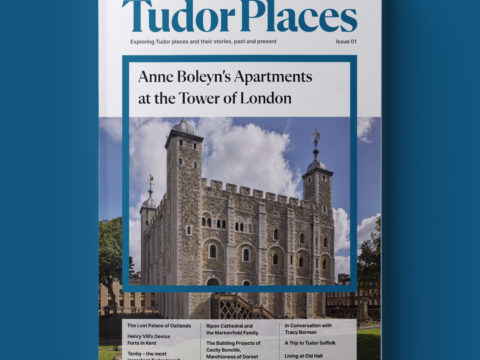Margaret Tudor: Life Story
Chapter 4 : Married Life
Margaret and James IV were married at Holyrood Abbey, Edinburgh on 8th August 1503 by the Archbishops of Glasgow and of York. Margaret was crowned following the nuptial mass, King James holding her around the waist for much of the ceremony and handing her the sceptre.
After a long day of feasting and revelry, the couple were reported to have retired to bed together. It is probable that the marriage was consummated, to render it indissoluble. Since Margaret’s first pregnancy did not occur until 1506 it may be that James, after the first night, left her to mature. He certainly didn’t see a necessity to break off his relationship with his mistress, Lady Janet Kennedy.
James treated Margaret courteously and kindly, granting her Kilmarnock as her morning gift and buying her clothes and jewels. Nevertheless Margaret was terribly homesick and wrote to her father excusing herself for dictating to her secretary because she had no time to write herself, but then adding in her own hand that she wished she were with him. She informed her father that the Earl of Surrey was in very good favour with James, something which would presumably have pleased Henry, however Margaret was a little irritated that Surrey organised her household without reference to either herself or Sir Ralph Verney. She signed herself his humble daughter, Margaret.
Margaret’s new husband was an inveterate traveller. Throughout his reign he travelled extensively, seldom staying more than a couple of days in any place. From the autumn of 1503, Margaret was often by his side. The Treasurer’s accounts show that significant sums were paid for the carriage of her belongings. Extensive travel by no means meant living without the usual luxuries of kingship. In particular James and Margaret enjoyed making music together and listening to professional players.
Not long after her marriage, Margaret, was presented with the evidence of James IV’s previous liaisons. In the nursery at Stirling were no fewer than half a dozen of his illegitimate children. Shortly after her introduction to them, the nursery was broken up and the children dispersed. James made generous provision for all of them, and we cannot be sure that this was not always his intention, although it has been assumed that was Margaret’s displeasure that led to the breakup of the nursery.
James appears to have done everything he could to please his young wife. The Christmas festivities for her first holiday season in her new country were particularly lavish and his New Year’s gifts to her included gold sapphires and pearl studded crosses.
Henry VII, despite his affection for his daughter, was less generous. Queen Margaret was waited upon by 24 English attendants but despite the obligation of the marriage treaty, Henry VII had not paid them. James wrote to Henry VII saying he would gladly pay for the attendance for his “dearest fellow and Queen” although he was not obliged to do so. Henry had however paid Margaret’s dowry promptly.
Margaret’s first pregnancy began in 1506, resulting in the birth of a son, named James, on 21st January 1507 and christened on the 23rd of that month at Holyrood. He was proclaimed as Prince of Scotland and Duke of Rothesay. As always, James was generous, giving £90 to the “Lady Maistres” who had given him the news, £7 to Margaret’s mid-wife and £14 to the baby’s nurse. Happiness soon turned to worry when shortly after the birth, both Margaret and baby James fell seriously ill. King James was so genuinely fond of his wife that, according to the 16th century history of Scotland by Bishop Leslie, her dangerous illness
“grevit him sa sair that he wald not be comforted: nouther of man wald receive ony consolatione.”
James determined to make a pilgrimage to the Shrine of Saint Ninian, making the 120 mile journey on foot to pray for her recovery; giving alms at the outer kirk, the rood, the altar, the high altar, the altar of Our Lady and the relics.
Whether through divine intercession or her own youth and strength, Margaret recovered, and suitably grateful Margaret herself also paid a visit to give thanks at the Shrine. Less overtly religious than her husband, she travelled by litter with her usual large accompaniment of baggage. But, after initial improvement, the baby died in February 1508. Margaret lost a daughter in July of that year but was pregnant again by early 1509.
Whilst Henry VII lived, the Treaty of Perpetual Peace, whilst sometimes threatened, never completely broke down. One or two disputes were settled, usually to the accompaniment of gifts.
Margaret, Queen of Scots
Family Tree




